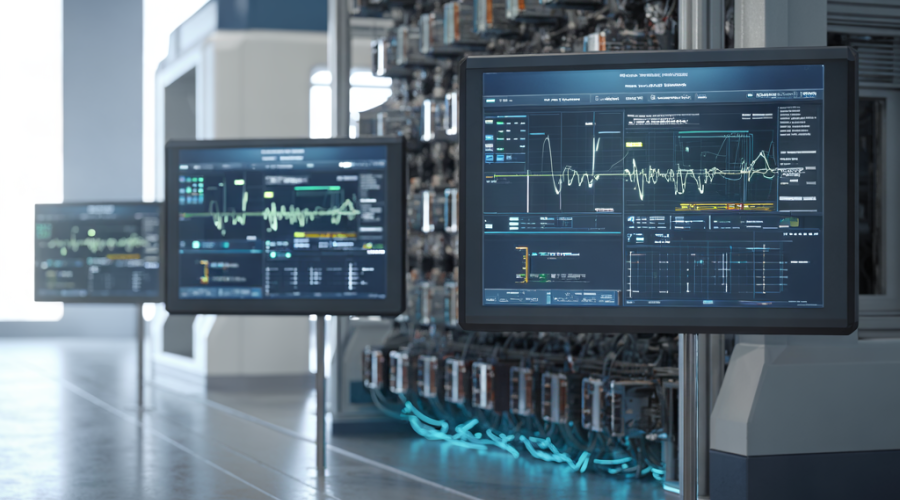
Electrical Signature Analysis (ESA) is an advanced, non-invasive condition monitoring technology that uses current and voltage analysis to detect faults early in electric motors and rotating equipment. It enables companies to predict failures before they occur, significantly reducing unplanned downtime and maintenance costs.
What is Electrical Signature Analysis?
ESA is a diagnostic method that continuously analyzes electrical signals (current and voltage) to identify subtle changes in machine operation that may indicate potential faults. Unlike traditional techniques that require direct access to equipment, ESA works remotely by analyzing data from motor control cabinets.
Main characteristics of ESA include:
- Online monitoring - operates while the machine is running
- Non-invasive - no need to stop production
- Comprehensive - analyzes the entire system from motor to load
- Precise - detects both electrical and mechanical faults
How Does ESA Work?
1. Data Collection
ESA uses sensors installed in motor control cabinets that continuously gather high-frequency electrical data. These sensors are designed to withstand harsh operating conditions and allow safe, easy installation.
2. Data Analysis
Collected data is processed with advanced algorithms, including Fast Fourier Transform (FFT), which convert the data from the time domain to the frequency domain. FFT allows identification of the machine’s "frequency signature" — a unique set of frequencies characterizing normal operation.
Key analytical techniques include:
- Spectral analysis - mapping the strength of various frequencies
- Lateral and torsional analysis - insights into machine vibrations
- Power analysis - identifying irregularities such as harmonic distortion
3. Pattern Recognition
ESA employs pattern recognition to identify specific fault types. Each fault type has a unique frequency "signature" that can be mathematically defined and recognized.
Benefits of ESA Technology
Early Fault Detection
ESA can detect early signs of equipment degradation much sooner than traditional methods. Electrical changes directly affect the motor’s magnetic field, which ESA can detect at a very early stage.
Comprehensive Monitoring
Unlike other techniques that focus on specific components, ESA provides a full-system view—from the electrical network to the final load. A single measurement session can detect issues in:
- Power supply and electrical installations
- Stator and rotor components
- Bearings and mechanical parts
- Drives and loads
Cost Efficiency
Implementing ESA as part of a predictive maintenance strategy can lead to significant savings by reducing emergency repairs, extending equipment lifespan, and optimizing maintenance schedules based on actual asset condition.
ESA Application Areas
- Industrial Manufacturing: Monitoring motors and conveyors, detecting issues such as rotor imbalance and bearing faults.
- Energy and Utilities: Monitoring generators, transformers, and electrical systems to enable early fault detection.
- Oil and Gas Industry: Monitoring pumps and compressors in remote and hazardous locations.
- Transport and Railways: Maintaining electric motors in optimal condition by detecting overheating or misalignment.
Types of Faults Detectable by ESA
Electrical Faults
- Broken rotor bars
- Inter-turn short circuits
- Power quality issues like unbalance and harmonic distortion
Mechanical Faults
- Misalignment and imbalance
- Bearing defects
- Frame looseness and eccentricity
- Cavitation in pumps
ESA vs. Other Monitoring Techniques
| Characteristic | ESA | Vibration Analysis | Thermography |
|---|---|---|---|
| Access | Non-invasive, remote | Direct contact with equipment | Visual inspection |
| Coverage | Entire system | Localized | Surface temperatures |
| Early Detection | Very early | Moderately early | Late |
| Electrical Faults | Excellent | Limited | Good |
| Mechanical Faults | Good | Excellent | Good |
Implementation and Challenges
- Technical Expertise: Requires specialized knowledge for analyzing electrical signals and interpreting data.
- Data Management: Large volumes of high-frequency data require efficient processing tools.
- Integration with Existing Equipment: Can be challenging in plants with legacy systems.
The Future of ESA Technology
- AI and Machine Learning Integration: Enhances predictive capabilities and detection accuracy.
- Advanced Sensors: Makes ESA more robust and precise in extreme conditions.
- IoT Integration: Enables centralized data processing and easier diagnostics.
Electrical Signature Analysis is a technology that enables early fault detection, improves reliability, and significantly reduces maintenance costs. For companies seeking equipment security and operational efficiency, ESA is an indispensable tool of modern maintenance.





Leave a comment